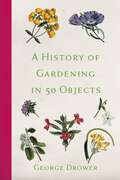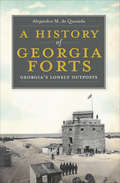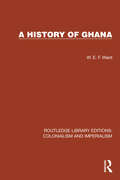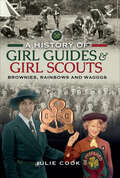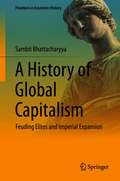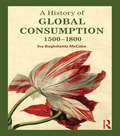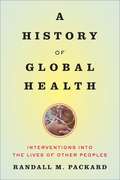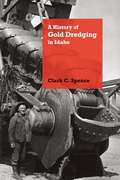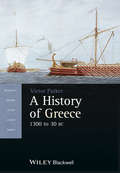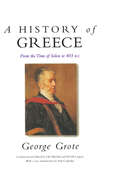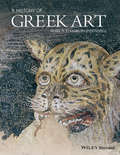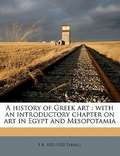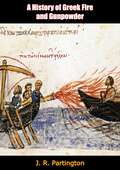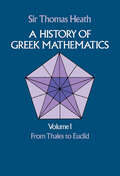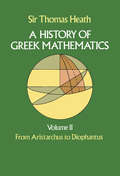- Table View
- List View
A History of Gardening in 50 Objects
by George DrowerThe earliest record of an enclosed space around a homestead come from 10,000 BC and since then gardens of varying types and ambition have been popular throughout the ages. Whether ornamental patches surrounding wild cottages, container gardens blooming over unforgiving concrete or those turned over for growing produce, gardens exist in all shapes and sizes, in all manner of styles.Today we benefit from centuries of development, be it in the cultivation of desirable blossom or larger fruits, in the technology to keep weeds and lawn at bay or even in the visionaries who tore up rulebooks and cultivated pure creativity in their green spaces.George Drower takes fifty objects that have helped create the gardening scene we know today and explores the history outside spaces in a truly unique fashion. With stunning botanical and archive images, this lavish volume is essential for garden lovers.
A History of Gender in America: Essays, Documents, and Articles
by Sylvia D. HoffertA reader for an undergraduate course assembling recent literature on the history of gender in the US, with section introductions setting the context of the period covered. A list of suggested readings replaces a bibliography. There is no index. Annotation c. Book News, Inc., Portland, OR (booknews.com)
A History of Genomics across Species, Communities and Projects (Medicine and Biomedical Sciences in Modern History)
by Miguel García-Sancho James LoweThis open access book offers a comprehensive overview of the history of genomics across three different species and four decades, from the 1980s to the recent past. It takes an inclusive approach in order to capture not only the international initiatives to map and sequence the genomes of various organisms, but also the work of smaller-scale institutions engaged in the mapping and sequencing of yeast, human and pig DNA. In doing so, the authors expand the historiographical lens of genomics from a focus on large-scale projects to other forms of organisation. They show how practices such as genome mapping, sequence assembly and annotation are as essential as DNA sequencing in the history of genomics, and argue that existing depictions of genomics are too closely associated with the Human Genome Project. Exploring the use of genomic tools by biochemists, cell biologists, and medical and agriculturally-oriented geneticists, this book portrays the history of genomics as inseparably entangled with the day-to-day practices and objectives of these communities. The authors also uncover often forgotten actors such as the European Commission, a crucial funder and forger of collaborative networks undertaking genomic projects. In examining historical trajectories across species, communities and projects, the book provides new insights on genomics, its dramatic expansion during the late twentieth-century and its developments in the twenty-first century. Offering the first extensive critical examination of the nature and historicity of reference genomes, this book demonstrates how their affordances and limitations are shaped by the involvement or absence of particular communities in their production.
A History of Georgia Forts: Georgia's Lonely Outposts (Landmarks Ser.)
by Alejandro M. de QuesadaA look at military fortifications over the centuries, with photos included. The state of Georgia has a long tradition of building stalwart military fortifications—going all the way back to the early sixteenth century, when it was part of a much larger region of the Southeast claimed by Spain and known as La Florida. After the failure of Lucas Vasquez de Ayllon&’s settlement in 1526 on the coast of Georgia, French Huguenots established a small fort at Port Royal Sound and another along the St. Johns River. This book explores the centuries that followed, revealing the history behind Georgia&’s many forts. Discover who emerged victorious after Savannah&’s Fort Pulaski was bombarded for over thirty hours by Federal troops during the Civil War, and why Fort Oglethorpe was constructed in 1902 within the confines of Chickamauga Park, as military historian and archivist Alejandro de Quesada explores the breadth of Georgia&’s forts from the colonial and antebellum eras to the Civil War and modern times.
A History of Germany 1715-1815 (Routledge Revivals)
by C.T AtkinsonPublished in 1908, this book documents the history of Germany between 1715 and 1815. The book explores international relations, conflicts, growth and cultural change in Germany in the space of 100 years.
A History of Germany 1918 - 2014: The Divided Nation
by Mary FulbrookThe fourth edition of A History of Germany, 1918-2014: A Divided Nation introduces students to the key themes of 20th century German history, tracing the dramatic social, cultural, and political tensions in Germany since 1918. Now thoroughly updated, the text includes new coverage of the Euro crisis and a review of Angela Merkel’s Chancellorship. New edition of a well-known, classic survey by a leading scholar in the field, thoroughly updated for a new generation of readers Provides an overview of the turbulent history of Germany from the end of the First World War through the Third Reich and beyond, examining the character and consequences of war and genocide Treats German history from 1918 to 2014 from the perspectives of instability, division and reunification, covering East and West German history in equal depth Offers important reflections on Angela Merkel’s Chancellorship as it extends into a new term Concise, substantive coverage of this period make it an ideal resource for undergraduate students
A History of Germany 1918 - 2020: The Divided Nation
by Mary FulbrookThe new edition of the acclaimed textbook on modern German history, written by a leading scholar in the field Now in its fifth edition, A History of Germany 1918-2020 provides a clear and well-balanced survey of German history from the creation of the Weimar Republic to the era of Angela Merkel’s Chancellorship. Guiding readers through the complex patterns of the nation’s historical development using clear and compelling narrative, this classic textbook introduces readers to the key themes of modern German history while tracing the social, cultural, and political tensions that have challenged German stability and unity across more than a century. Fully updated for the next generation of readers, A History of Germany 1918-2020 extends its framework for exploring legacies of the past into the 21st century. The fifth edition includes enhanced coverage of the extremes of nationalism, military aggression, and genocide under Nazism, as well as an expanded analysis of the Berlin Republic and the changing character of Germany in the Europe of 2020. Presenting readers with a panoramic overview of the past 100 years of German history, this compelling textbook: Provides a concise yet thorough account of the turbulent history of Germany from the end of the First World War to the present Examines the character and consequences of World War II and the Holocaust Explores the development of a capitalist democracy in West Germany and a communist dictatorship in East Germany during the Cold War Covers East and West German history in equal depth from the perspectives of instability, division, and reunification Analyses the fall of Communism and the unification of an enlarged Federal Republic in 1989-90 Traces unified Germany’s development as a globally respected state playing a pivotal role in Europe today A History of Germany 1918-2020: The Divided Nation, Fifth Edition remains the ideal text for undergraduate students in courses on modern German or European history, as well as for general readers with interest in the subject.
A History of Germany 1918-2008
by Mary FulbrookThe third edition of A History of Germany traces the dramatic social, cultural, and political tensions in Germany since 1918. Offers a persuasive interpretation of the dynamics of twentieth-century German historyTreats German history from 1918-2008 from the perspective of division and reunification, covering East and West German history in equal depthCovers the self-destructive Weimar Republic, the extremes of genocide and military aggression in the Nazi era, the division of the nation in the Cold War, and the collapse of communist East Germany and unification in 1990New edition includes updates throughout, especially covering the Nazi period and the Holocaust; a new chapter on Germany since the 1990s; and a substantially revised and updated bibliography
A History of Ghana (Routledge Library Editions: Colonialism and Imperialism #1)
by W.E.F. WardA History of Ghana (1958) uses both European archives and considerable research among African traditional histories to examine the history of the Gold Coast and Ghana. The African histories are particularly important, as many village traditions, and more so those of larger towns, have traditions that date back hundreds of years, and whose accuracy can be tallied with those of their neighbours. Accounts from Western sources do not shy away from detailing British mistakes in government, and the resulting book is an even-handed history with much under-read research direct from African sources.
A History of Ghosts: The True Story of Séances, Mediums, Ghosts, and Ghostbusters
by Peter H. Aykroyd Angela NarthPeter Aykroyd spent his childhood watching his family's parlor séances through the crack of a basement door. Here, for the first time, Aykroyd tells the strange and delightful story that inspired his son, Dan, to make the mega-hit, Ghostbusters. Part history, part family legend, A History of Ghosts starts in 1848 in upstate New York, where the spiritualist craze first began. Aykroyd introduces the reader to notable mediums while telling the story of the development of spiritualism, interweaving a personal history marked by a fascination with ghosts and spirits with the larger narrative about the role the paranormal has played in our culture. Such legendary figures as Sir Arthur Conan Doyle and Harry Houdini appear and vanish. Everyone loves a good ghost story. Successful TV shows such as Medium and Ghost Hunters are proof that our national obsession with ghosts is here to stay. Millions of Americans believe in the paranormal—and even skeptics have heard a bump in the night and suspected it might be something supernatural.
A History of Girl Guides & Girl Scouts: Brownies, Rainbows and WAGGGS
by Julie CookA History of Girl Guides and Girl Scouts: Brownies, Rainbows and WAGGGS charts the evolution of the Girl Guides and Girl Scouts from its early days as a movement started before WW1 right through to the modern day. With real life interviews with Girl Guides and Girl Scouts from their 90s down to young children, this book looks at what being a Girl Guide has meant through the ages up to the present day. With dramatic and often emotional stories of what it was like to be an evacuated Brownie in the Second World War, a disabled Girl Guide and with tales of girls' heroism throughout the two great wars both in the UK and the United States, this book extols the Guiding and Scouting movement as one that has evolved with women and girls' rights and its hopes for the future.
A History of Global Capitalism: Feuding Elites and Imperial Expansion (Frontiers in Economic History)
by Sambit BhattacharyyaThe book sets out to explore the economic motivations of imperial expansion under capitalism. This undoubtedly is related to two fundamental research questions in economic sciences. First, what factors explain the divergence in living standards across countries under the capitalist economic system? Second, what ensures internal and external stability of the capitalist economic system? The book adopts a unified approach to address these questions. Using the standard growth model it shows that improvements in living standards are dependent on access to raw materials, labour, capital, technology, and perhaps most importantly 'economies of scale'. Empires ensure scale economy through guaranteed access to markets and raw materials. The stability of the system depends on growth and distribution and it is not possible to have one without the other. However, the quest for growth and imperial expansion implies that one empire invariably comes into conflict with another. This is perhaps the most unstable and potentially dangerous characteristic of the capitalist system. Using extensive historical accounts the book shows that this inherent tension can be best managed by acknowledging mutual spheres of influence within the international system along the lines of the 1815 Vienna Congress. This timely publication addresses not only students and scholars of economics, geography, political science, and history, but also general readers interested in a better understanding of economic development, international relations, and the history of global capitalism.
A History of Global Consumption: 1500 - 1800
by Ina Baghdiantz McCabeIn A History of Global Consumption: 1500 – 1800, Ina Baghdiantz McCabe examines the history of consumption throughout the early modern period using a combination of chronological and thematic discussion, taking a comprehensive and wide-reaching view of a subject that has long been on the historical agenda. The title explores the topic from the rise of the collector in Renaissance Europe to the birth of consumption as a political tool in the eighteenth century. Beginning with an overview of the history of consumption and the major theorists, such as Bourdieu, Elias and Barthes, who have shaped its development as a field, Baghdiantz McCabe approaches the subject through a clear chronological framework. Supplemented by illlustrations in every chapter and ranging in scope from an analysis of the success of American commodities such as tobacco, sugar and chocolate in Europe and Asia to a discussion of the Dutch tulip mania, A History of Global Consumption: 1500 – 1800 is the perfect guide for all students interested in the social, cultural and economic history of the early modern period.
A History of Global Health: Interventions into the Lives of Other Peoples
by Randall M. Packard<p>Over the past century, hundreds of billions of dollars have been invested in programs aimed at improving health on a global scale. Given the enormous scale and complexity of these lifesaving operations, why do millions of people in low-income countries continue to live without access to basic health services, sanitation, or clean water? And why are deadly diseases like Ebola able to spread so quickly among populations? <p>In A History of Global Health, Randall M. Packard argues that global-health initiatives have saved millions of lives but have had limited impact on the overall health of people living in underdeveloped areas, where health-care workers are poorly paid, infrastructure and basic supplies such as disposable gloves, syringes, and bandages are lacking, and little effort has been made to address the underlying social and economic determinants of ill health. Global-health campaigns have relied on the application of biomedical technologies―vaccines, insecticide-treated nets, vitamin A capsules―to attack specific health problems but have failed to invest in building lasting infrastructure for managing the ongoing health problems of local populations. <p>Designed to be read and taught, the book offers a critical historical view, providing historians, policy makers, researchers, program managers, and students with an essential new perspective on the formation and implementation of global-health policies and practices.</p>
A History of Global Health: Interventions into the Lives of Other Peoples
by Randall M. PackardA sweeping history explores why people living in resource-poor areas lack access to basic health care after billions of dollars have been invested in international-health assistance.Over the past century, hundreds of billions of dollars have been invested in programs aimed at improving health on a global scale. Given the enormous scale and complexity of these lifesaving operations, why do millions of people in low-income countries continue to live without access to basic health services, sanitation, or clean water? And why are deadly diseases like Ebola able to spread so quickly among populations?In A History of Global Health, Randall M. Packard argues that global-health initiatives have saved millions of lives but have had limited impact on the overall health of people living in underdeveloped areas, where health-care workers are poorly paid, infrastructure and basic supplies such as disposable gloves, syringes, and bandages are lacking, and little effort has been made to address the underlying social and economic determinants of ill health. Global-health campaigns have relied on the application of biomedical technologies—vaccines, insecticide-treated nets, vitamin A capsules—to attack specific health problems but have failed to invest in building lasting infrastructure for managing the ongoing health problems of local populations.Designed to be read and taught, the book offers a critical historical view, providing historians, policy makers, researchers, program managers, and students with an essential new perspective on the formation and implementation of global-health policies and practices.
A History of Gold Dredging in Idaho (Mining the American West)
by Clark C. SpenceA History of Gold Dredging in Idaho tells the story of a revolution in placer mining—and its subsequent impact on the state of Idaho—from its inception in the early 1880s until its demise in the early 1960s. Idaho was the nation’s fourth-leading producer of dredged gold after 1910 and therefore provides an excellent lens through which to observe the practice and history of gold dredging. Author Clark Spence focuses on the two most important types of dredges in the state—the bucket-line dredge and the dragline dredge—and describes their financing, operation, problems, and effect on the state and environment. These dredges made it possible to work ground previously deemed untouchable because bedrock where gold collected could now be reached. But they were also highly destructive to the environment. As these huge machines floated along, they dumped debris that harmed the streams and destroyed wildlife habitat, eventually prompting state regulations and federal restoration of some of the state’s crippled waterways. Providing a record of Idaho’s dredging history for the first time, this book is a significant contribution to the knowledge and understanding of Western mining, its technology, and its overall development as a major industry of the twentieth century.
A History of Golf in Georgia (Sports)
by John CompaniotteGolf first came to Georgia in the late eighteenth century when a group of avid golfers banded together to form a club in Savannah. By the end of the nineteenth century, when the game had become popular, the state developed courses from border to border. More than four hundred courses now dot the landscape of the Peach State. Georgia native and golfing icon Bobby Jones won four of golf's most coveted titles in 1930: the British Amateur, British Open, U.S. Open and U.S. Amateur. For one hundred years, the state has produced champion golfers at every level, hosted amateur and professional championships and provided support for the global sport. Author John Companiotte offers the compelling story of golf's rise and prosperity in Georgia.
A History of Golf: The Royal and Ancient Game (Golf Classics Ser.)
by Robert BrowningHere is a book which should prove a valuable and every welcome addition to the literature of Golf!Written in a fluent and easy style that makes reading a pleasure, this new history has the merit of literary quality, and the author’s quiet, unobtrusive sense of humour eliminates the slightest suspicion of dullness or heaviness, without in any way detracting from the seriousness of his objective or the dignity and importance that even the most rabid devotee of the Royal and Ancient would claim for it. The work also provides ample evidence of the author’s industry and research, and, in keeping with his position as editor of Golfing, conveys a quiet assurance of authority.The book deals with every aspect of the history of the game, from its earliest beginnings to the modern era of American ascendency. There are 34 chapters and a chronological table covering 600 years from 1353 to the 1950’s. We select here, more or less at random, a few of the subjects dealt with: Seven successive monarchs of the Stuart line as players—The golf of the House of Windsor—Golf as a cross-country game—The Celtic hurley, and the Belgian chole—The Scots game and the Dutch—The origin of golfing terms—Golf before the formation of clubs—Competitions came before clubs—The beginning of the championships—The start of the university match—How golf came to London—The golf boom of the gay nineties—The beginning of golf in America—The evolution of the professionals—Women’s golf originally a part of the feminist movement—Clubs and balls; wooden balls; the old featheries; the coming of the ‘gutties’; the arrival of the rubber core—Course construction—The rise of the golf architects—The evolution of the rules—American thoroughness makes golf a science instead of an art—International golf; the Walker, Ryder, and Curtis Cups—The game as a preserver of ancient landmarks—The genius of golf, the only game in which the worst player gets the best of it.
A History of Greece, 1300 to 30 BC (Blackwell History of the Ancient World)
by Victor ParkerA History of Greece: 1300‒30 BC, offers a comprehensive introduction to the foundational political history of Greece, from the late Mycenaean Age through to the death of Cleopatra VII, the last Hellenistic monarch of Egypt. Introduces textual and archaeological evidence used by historians to reconstruct historical events during Greece’s Bronze, Archaic, Classical, and Hellenistic periods Reveals the political and social structure of the Greek world in the late Mycenaean period (thirteenth century BC) through analysis of the Linear B tablets, the oldest surviving records in Greek Features numerous references to original source materials, including various fragmentary papyri, inscriptions, coins, and other literary sources Provides extensive coverage of the Hellenistic period, and covers areas excluded from most Greek history texts, including the Greek West Features judicious use of illustrations throughout, and considers instructors’ teaching needs by structuring the later sections to facilitate teaching a parallel course in Roman History Balances scholarship with a reader-friendly approach to create an accessible introduction to the political history of one of most remarkable ancient civilizations and sophisticated periods of world history
A History of Greece: From the Time of Solon to 403 BC (A\history Of Greece Ser. #Vol. 4)
by George GroteGrote's History of Greece is one of the classic works of historical interpretation and scholarship. George Grote - banker, MP and a founder of London University - was the first historian to give a high value to the Greek creation of democracy, and this aspect of his work is closely relevant to current debates about democracy in our times. This abridgement of the original twelve volume work, which was made in the early years of the century and published by George Routledge and sons, is now available again and makes accessible the essential Grote.In a new and original introduction, based on the latest research into Grote and into Greek history, Paul Cartledge places Grote's history in its intellectual context, discusses its salient features and traces its subsequent reception over the past century and a half.
A History of Greek Art
by Mark D. Stansbury-O'DonnellOffering a unique blend of thematic and chronological investigation, this highly illustrated, engaging text explores the rich historical, cultural, and social contexts of 3,000 years of Greek art, from the Bronze Age through the Hellenistic period. Uniquely intersperses chapters devoted to major periods of Greek art from the Bronze Age through the Hellenistic period, with chapters containing discussions of important contextual themes across all of the periods Contextual chapters illustrate how a range of factors, such as the urban environment, gender, markets, and cross-cultural contact, influenced the development of art Chronological chapters survey the appearance and development of key artistic genres and explore how artifacts and architecture of the time reflect these styles Offers a variety of engaging and informative pedagogical features to help students navigate the subject, such as timelines, theme-based textboxes, key terms defined in margins, and further readings. Information is presented clearly and contextualized so that it is accessible to students regardless of their prior level of knowledge A book companion website is available at www.wiley.gom/go/greekart with the following resources: PowerPoint slides, glossary, and timeline
A History of Greek Art / With an Introductory Chapter on Art in Egypt and Mesopotamia
by F. B. TarbellN/A
A History of Greek Fire and Gunpowder
by J. R. PartingtonFor nearly 600 years, from the battles of the early fourteenth century to the dropping of the atomic bomb at Hiroshima, firearms derived from gunpowder and other chemicals defined the frightful extent of war. The apparatus and materials used in World War I would have been familiar to our remote ancestors. In this classic work, first published in 1960, James Riddick Partington provides a worldwide survey of the evolution of incendiary devices, Greek fire, and gunpowder.Greek fire...was most famously used in the sieges of Constantinople and the Crusades. Partington moves from its antecedents “other incendiaries used in ancient warfare” to European gunpowder recipe books (The Latin Book of Fire, Bellifortis, and Feuerwerkbuch) and the history of infernal machines, mines, canon, small arms, and artillery. His book includes chapters on gunpowder and weapons in Muslim lands, India, and China including fire books, the use of gunpowder as a propellant, the artillery of the Mughal Emperors, and the use of saltpetre in explosives. He traces the development of gunpowder to eleventh-century China and cites the first known mention and picture of a firearm in 1326."The history of gunpowder and firearms has attracted many authors with varying interests. The general historian must take account of major inventions effecting revolutions in the life of nations. The historian of science is concerned mostly with the invention of gunpowder. The historian of technology examines the development in the manufacture of explosives and weapons, and the way in which gunpowder has found applications in the peaceful arts. The military historian deals mainly with the use of gunpowder as an explosive and a propellant... and the development of firearms and their use in warfare. No recent book in English (or for that matter in any language) has attempted a concise survey of the subject.”-Preface
A History of Greek Mathematics, Volume I: From Thales to Euclid
by Thomas Heath"As it is, the book is indispensable; it has, indeed, no serious English rival." — Times Literary Supplement. "Sir Thomas Heath, foremost English historian of the ancient exact sciences in the twentieth century." — Professor W. H. Stahl"Indeed, seeing that so much of Greek is mathematics, it is arguable that, if one would understand the Greek genius fully, it would be a good plan to begin with their geometry." The perspective that enabled Sir Thomas Heath to understand the Greek genius — deep intimacy with languages, literatures, philosophy, and all the sciences — brought him perhaps closer to his beloved subjects and to their own ideal of educated men, than is common or even possible today. Heath read the original texts with a critical, scrupulous eye, and brought to this definitive two-volume history the insights of a mathematician communicated with the clarity of classically taught English. "Of all the manifestations of the Greek genius none is more impressive and even awe-inspiring than that which is revealed by the history of Greek mathematics." Heath records that history with the scholarly comprehension and comprehensiveness that marks this work as obviously classic now as when it first appeared in 1921. The linkage and unity of mathematics and philosophy suggest the outline for the entire history. Heath covers in sequence Greek numerical notation, Pythagorean arithmetic, Thales and Pythagorean geometry, Zeno, Plato, Euclid, Aristarchus, Archimedes, Apollonius, Hipparchus and trigonometry, Ptolemy, Heron, Pappus, Diophantus of Alexandria and the algebra. Interspersed are sections devoted to the history and analysis of famous problems: squaring the circle, angle trisection, duplication of the cube, and an appendix on Archimedes' proof of the subtangent property of a spiral. The coverage is everywhere thorough and judicious; but Heath is not content with plain exposition: It is a defect in the existing histories that, while they state generally the contents of, and the main propositions proved in, the great treatises of Archimedes and Apollonius, they make little attempt to describe the procedure by which the results are obtained. I have therefore taken pains, in the most significant cases, to show the course of the argument in sufficient detail to enable a competent mathematician to grasp the method used and to apply it, if he will, to other similar investigations. Mathematicians, then, will rejoice to find Heath back in print and accessible after many years. Historians of Greek culture and science can renew acquaintance with a standard reference; readers in general will find, particularly in the energetic discourses on Euclid and Archimedes, exactly what Heath means by impressive and awe-inspiring.
A History of Greek Mathematics, Volume II: From Aristarchus to Diophantus
by Thomas HeathThe perspective that enabled Sir Thomas Heath to understand the Greek genius — deep intimacy with languages, literatures, philosophy, and all the sciences — brought him perhaps closer to his beloved subjects, and to their own ideal of educated men than is common or even possible today. Heath read the original texts with a critical, scrupulous eye and brought to this definitive two-volume history the insights of a mathematician communicated with the clarity of classically taught English."Of all the manifestations of the Greek genius none is more impressive and even awe-inspiring than that which is revealed by the history of Greek mathematics." Heath records that history with the scholarly comprehension and comprehensiveness that marks this work as obviously classic now as when it first appeared in 1921. The linkage and unity of mathematics and philosophy suggest the outline for the entire history. Heath covers in sequence Greek numerical notation, Pythagorean arithmetic, Thales and Pythagorean geometry, Zeno, Plato, Euclid, Aristarchus, Archimedes, Apollonius, Hipparchus and trigonometry, Ptolemy, Heron, Pappus, Diophantus of Alexandria and the algebra. Interspersed are sections devoted to the history and analysis of famous problems: squaring the circle, angle trisection, duplication of the cube, and an appendix on Archimedes's proof of the subtangent property of a spiral. The coverage is everywhere thorough and judicious; but Heath is not content with plain exposition: It is a defect in the existing histories that, while they state generally the contents of, and the main propositions proved in, the great treatises of Archimedes and Apollonius, they make little attempt to describe the procedure by which the results are obtained. I have therefore taken pains, in the most significant cases, to show the course of the argument in sufficient detail to enable a competent mathematician to grasp the method used and to apply it, if he will, to other similar investigations.Mathematicians, then, will rejoice to find Heath back in print and accessible after many years. Historians of Greek culture and science can renew acquaintance with a standard reference; readers in general will find, particularly in the energetic discourses on Euclid and Archimedes, exactly what Heath means by impressive and awe-inspiring.
